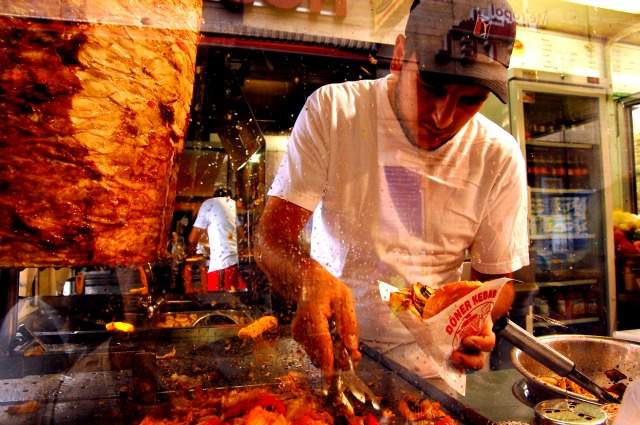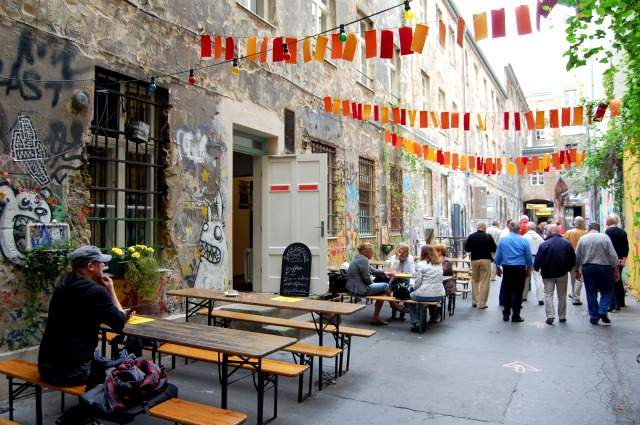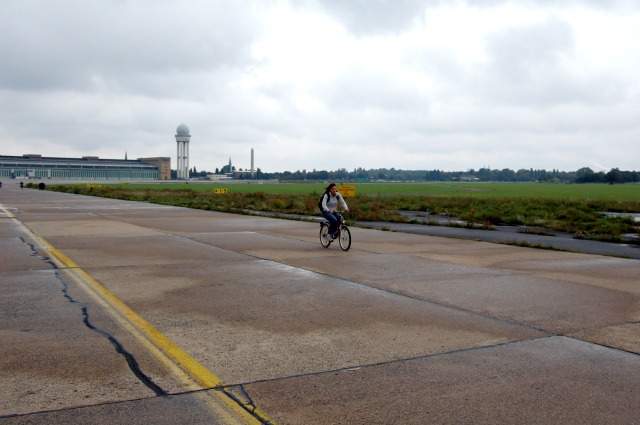Over dinner one night in Berlin, my companions struggled to summarize the city. “Berlin is like New York in the 70’s,” one said. Another suggested it was like Paris in the 60’s, while still another offered up London in the 80’s. Berlin is the quintessential “riddle, wrapped in a mystery, inside an enigma,” a city that presents more questions than answers, that leads you down the rabbit hole as you try to figure out just what makes it tick, and what it means to be a Berliner.
How does a place that has seen so much death and destruction, so much horror and hate, so much fear and oppression ever recover, much less grow into a progressive city full of parks and gardens? What attracts so many creative people here and how is it that a city so filled with history can continually reinvent itself? I don’t have the answers, but what I do know is that you should go.
You should go now. And when you do, here are a few hints to help you begin to understand the incredible, living, breathing, ever-changing city of Berlin. Maybe you’ll find some of the answers to these questions, but even if you don’t, you might end up (as I did) falling madly love with the city as you try.
Check out these tips for having an indie travel experience in Berlin.
Berlin is big – really, really big
With a population of 3.4 million making it the second most populous city in the European Union, Berlin is….well, huge. The city is nine times the size of Paris, so bring your walking shoes and come prepared to master the extensive public transportation system. But it’s not just common urban sprawl that accounts for the city’s massive size.
Berlin was divided by the infamous Wall from 1961 to 1989 and so East Berlin and West Berlin grew as two distinct city centers. When the Wall came down, these two big cities combined to become one giant city. Most of the main tourist attractions, like Brandenburg Gate, the DDR Museum, and Checkpoint Charlie, are in the east or right on the old border of east and west. Many people choose to stay in the centrally located Mitte district, or just to the west in Tiergarten or Potsdamer Platz, but no matter where you stay, you’ll need to do a lot of walking and get familiar with public transport to make the most of your stay.
>> Buy the Berlin Welcome Card, which starts at €17 for 48 hours and covers all your transport and gives you discounts of 25-50% at over 200 attractions.
History is everywhere in Berlin
Berlin’s history is long and (at times) terrible, yet the past seems neither to be hidden in shame nor pushed to the spotlight. It’s simply all around, always there, a silent companion to everyday life. Museums and sights like the Topography of Terror and the Memorial to the Murdered Jews of Europe are free, as though the city refuses to profit from the atrocities committed there. And at the latter, the nearly 5 acre site blends seamlessly into the cityscape. If one didn’t know better he might assume this plot of uneven cobblestones and row upon row of 2,711 concrete pillars of varying heights, in which children play hide-and-seek and young lovers have clandestine meetings, was just an avant-garde city park. Instead it stands, without fanfare, in remembrance.
One of the three remaining sections of the Berlin Wall, located alongside the River Spree in the Friedrichshain district, is now known as the Eastside Gallery, a 1.3 kilometer section of the Wall that was painted with murals by artists from all over the world. On the mural side, tourists snap photos while on the other side, locals relax on the grassy riverbank. And all over the city (and throughout Germany) thousands of small brass stumble stones (or Stolperstein) are set into the sidewalks. Inscribed on each stone is the name, date of birth, and date and place of death, if known, for a single person who lived or worked at that location. Hidden in plain sight, the stones quietly honor those who were persecuted by the Nazis.
Berlin is multi-cultural, and so is its food
Like any big city, Berlin is home to many cultures, a fact reflected in the faces of the people in the street, the art, and most definitely in the food. You can easily find French, Italian, Spanish Portuguese, Chinese, Indian, Japanese and Thai food throughout the city. While of course you can also enjoy traditional German food in Berlin, it’s impossible to put the city’s cuisine into so narrow a category.
One of the largest ethnic groups in Berlin is Turkish. In the 1960’s, due in part to the construction of the Wall, Berlin experienced a labor shortage and began to recruit guest workers from Turkey, many of whom decided to stay after the work was done. In the neighborhood of Kreuzberg, this is particularly evident in the number of Turkish restaurants that line the streets. By all means, try the typical German fare of sausages, pretzels, and currywurst, but don’t miss out on a Turkish dinner or, on a smaller budget, a doner kebap sandwich which can be bought from a streetside stand for under €5.
>> Check out delicious street foods from around the world
Berlin is a bargain
Berlin isn’t the cheapest destination on the continent, but among the most touristed cities in Europe, it’s a great value. Measured by number of hotel stays sold, Berlin is now the third most visited city in Europe (behind London and Paris, but before Rome). Despite its popularity, it remains on the lower end of the Western Europe budget spectrum.
The average price of a 3-star hotel room is just €76, about half of the cost of the top two cities. Many of the biggest tourist attractions are free (or you can get a discount with the Berlin Welcome Card), a 24-hour bike rental costs €10 and a dorm bed in a hostel can be had for as little as €10-12 a night. If you eat cheap, sampling from street carts, neighborhood markets and local fast food places, it’s easy to get a delicious meal for under €5 in Berlin. A beer from a convenience store will be under one euro, with a bottle of wine available for less than five.
>> Find more budget destinations in Europe
Berlin is an unconventional beauty
Long before the trials of the last century, Berlin has always been a place on the verge. It’s one of the youngest capitals in Europe, designated so in 1871. In the early 1900’s, it was a haven for artists, writers, philosophers and intellectuals. It boasted more coffee houses than Vienna and was the center of cabaret culture. And through the years, it has remained a magnet for the avant-garde.
Tourists who visit the great cities of Europe and expect nothing but pristine ruins and charming cobblestone streets, only to be appalled by chaotic traffic and ugly graffiti, may not understand modern Berlin’s allure. Graffiti is a fact of life in most cities, but in Berlin, it’s a way of life and goes far beyond simple tagging. Street art – and it is art – is everywhere in Berlin. From political paste-ups to colorful stencils to beautiful murals that require every bit as much talent as anything you’ll see on canvas, Berlin’s street art runs the gamut and permeates the entire city.
Grab your camera, hit the streets and keep your eyes peeled at street level and up above – many of the city’s most impressive pieces are those done on the sides of buildings high above street level. Or book a street art tour with Alternative Berlin. For €15, you’ll be led on a guided tour through the streets of Berlin and to some of the studios of the city’s best artists. The tour even includes a workshop where you’ll learn how to make your own street art.
>>Check out other great cities for street art
You can always find your space in Berlin
Despite its large population, Berlin never seems overrun with people, thanks to over 2500 public parks and gardens. From the city’s famous green heart, the Tiergarten, to lesser-known retreats like Treptower Park in the east, there is always a quiet space nearby. Plan at least a few free hours to join the locals for a relaxing afternoon or evening; pack a picnic lunch and a few beers and claim your spot, or try to befriend someone with a bbq grill.
For something a little less ordinary, head south of the city center to Tempelhofer Park, the former Tempelhof Airport where the Berlin Airlift brought supplies to the city in 1948-49. In the shadow of what was once one of the largest buildings on Earth (the terminal, built between 1936 and 1941), locals and residents come to run, bike, and rollerblade on the runway, and fly kites and bbq throughout the 4-square kilometer park, the largest in continental Europe. And if that’s not enough quirk for you, head to Prenzlauer Berg’s Mauerpark for a Sunday fleamarket and Bearpit Karaoke, an open-air community karaoke event known for its supportive audience.
>> Discover the most beautiful gardens in Europe
Berlin is always becoming
Art historian Karl Scheffler said in 1910, “Berlin is a city condemned forever to becoming and never to being.” In 1892, Mark Twain declared, “Berlin is the newest city I have come across.” And in 2001, former French culture minister Jack Lang said, “Paris is always Paris and Berlin is never Berlin!” Though each statement was made at a different point in history, each still rings true today. No place is stagnant; even the smallest cities change over time. But no city changes like Berlin.
A strong alternative community of artists, musicians and other creative types on the edge of society, combined with rapid gentrification of neighborhoods, means that Berliners always seem to be looking for the next hot neighborhood, the new hip place, the latest cool thing. And with the city’s history, it’s not surprising that Berliners are always reinventing themselves and their city.
In the GDR, people had few choices. They did the jobs they were given. They ate the food that was available. As one woman who grew up in East Berlin put it, “We never went hungry, but we had little choice in the food we ate. If we were lucky enough to get jeans – if the shopkeeper told my mom what day they would arrive so we’d get there early – there was no talk of different styles. We took what we could get.” After years of a life without options, it’s easy to understand why the people – now free to do, eat, wear, and be whatever they wanted – might never be able to make a final decision and choose instead to sample from the endless options available.
>> Find more reasons to visit post-Communist countries now
Berlin is always becoming a new version of itself. You can’t pin it down. You can’t place it neatly in a box or label it for your archives. It will keep changing, keep moving, continually evading your efforts to define it. And therein lies much of its appeal. So put down the label-maker, and stop searching for the perfect phrase to sum it up. Just go and enjoy. But go now, because the Berlin of today will be different tomorrow.
Ready to go? Find cheap flights to Berlin book a hostel in Berlin or a Berlin budget hotel, read our Berlin travel guide or go to the Visit Berlin website. AirBerlin offers nonstop flights to Berlin from New York and Miami, with connecting flights to/from several others.
Photos by: pellesten, PilotGirl, douglas _arellanes, all others by the author
I was a guest of Visit Berlin and AirBerlin, but my opinions are my own.






